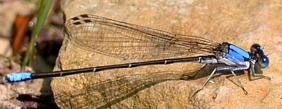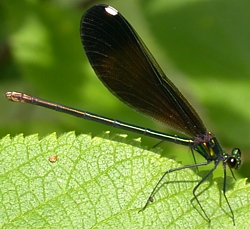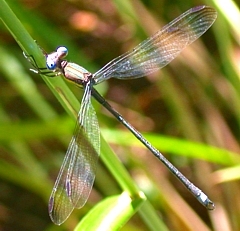|
|
ARTHROPODS:
Insects»
Spiders»
Centipedes»
Millipedes»
Sowbugs»
Harvestmen»
Mites
& Ticks»
Scorpions»
Identification
Tips»
About
the Critter Files»
Links» |
|
|
|
 |
DAMSELFLIES
Critter
Files/Insects/Damselflies
By Blake Newton
University of Kentucky Department of Entomology |
| |
|
| Common
Kentucky Damselflies: |
| |
| TAXONOMY |
KINGDOM: Animalia
| PHYLUM: Arthropoda | CLASS: Insecta | ORDER: Odonata | SUBORDER:
Zygoptera (damselflies) |
| |
WHAT
IS A DAMSELFLY?
LIFE CYCLE
ECOLOGY
PEST STATUS
COMMON KENTUCKY DAMSELFLIES
COLLECTING & PHOTOGRAPHY
DAMSELFLY FACTS
MYTHS, LEGENDS, AND FOLKLORE |
| |
| WHAT
IS A DAMSELFLY? |
|
| Like all insects, damselflies
have 6 legs, 2 antennae, and 3 body parts. Adult damselflies
are long, narrow insects with 2 pairs of wings, chewing mouthparts,
and large compound eyes. Damselfly antennae are very short,
and cannot be seen without close inspection. Damselflies are
close relatives of dragonflies,
and look very similar, but dragonflies are unable to fold their wings
over their backs, whereas most damselflies fold their wings up over
their bodies when they are not flying. Young damselflies are
called "nymphs" or "naiads", and they are fully
aquatic. They are also long and narrow and resemble adult damselflies
except that they are wingless. Damselfly naiads have 3 feathery
gills on the tips of their abdomens (which dragonfly naiads do not
have). |
|
| SIZE:
Most damselfly adults are about 1 ½" long, but some can
be up to 2". Naiads grow to be about 1 ½". |
| |
| LIFE
CYCLE |
|
Damselflies
have incomplete metamorphosis. After hatching from eggs, damselfly
naiads live and grow underwater and molt (shed their skins) several
times before they climb to the surface of the water and shed their
skins a final time to become winged adults. Adults are active
in the spring, summer, or fall, depending on the species. Like
dragonflies, damselflies mate while flying. Most female damselflies
dip their abdomens into water to deposit eggs. Others insert
the eggs into the stems of underwater plants, while other species
place their eggs on parts of plants that extend above the water.
|
| |
 Damselfly Naiad
(B. Newton, 2004)
Damselfly Naiad
(B. Newton, 2004) |
| |
| ECOLOGY |
|
Though most damselflies
are smaller than dragonflies, they are very similar to dragonflies
in almost every way. Just like dragonfly naiads, damselfly
naiads feed on minnows, tadpoles, aquatic insects, and other aquatic
prey. The naiads are primarily ambush predators: they find
a strategic spot on an underwater leaf or under a rock and wait
for prey to swim close enough to grab with their extendable jaws.
Damselfly naiads are eaten by many fish species, and also
by larger predatory aquatic insects. Adult damselflies are
also predators. They are very good fliers, able to swerve,
dive, and quickly change directions to catch flying insects. Because
they are smaller, damselflies are often eaten by dragonflies. Damselflies
are also eaten by birds and web-building spiders.
|
| |
| PEST
STATUS |
|
Like dragonflies,
damselflies are not pests. They are considered beneficial because
they eat mosquitoes and other pests. |
| |
| COMMON
KENTUCKY DAMSELFLIES |
|
| We have
many common dragonfly species in Kentucky. They all have similar
behavior, but some are found near ponds, others are more common near
streams and rivers. Pictured below are some of the most commonly
encountered Kentucky damselflies. |
|
|
NARROW-WINGED
DAMSELFLIES
FAMILY: Coenegrionidae
Most of the damselflies
encountered in Kentucky are Narrow-winged Damselflies,
including those in the Argia and Enallagma genera. These
small, fragile-looking damselflies are common near ponds and slow
moving streams.
Many narrow-winged damselflies are named after their colors -- common
varieties include Violet Tails and Bluets. |
| |
 Narrow-winged
damselfly (B. Newton, 2003)
Narrow-winged
damselfly (B. Newton, 2003) |
| |
 Narrow-winged
damselfly
with prey (B. Newton, 2005)
Narrow-winged
damselfly
with prey (B. Newton, 2005) |
|
|
|
BROAD-WINGED
DAMSELFLIES
FAMILY:
Calopterygidae
Broad-winged Damselflies
are common near Kentucky streams. These damselflies
are fairly large (2" long), and common species have shiny blue-black
or green-black bodies with black or dark-brown wings. The Calopteryx
species pictured below is very common along the Elkhorn Creek in Fayette
County. |
| |

Broad-winged
Damselfly, Calopteryx genus (B. Newton, 2003)
|
|
|
|
SPREAD-WINGED
DAMSELFLIES
FAMILY: Lestidae
Spread-winged Damselflies (Family Lestidae) are
not seen as often as narrow-winged and broad-winged damselflies.
Unlike most damselflies, spread-winged damselflies hold their
wings out when they are not flying, so they look a little more like
dragonflies. Their long, skinny bodies distinguish them as
damselflies, though. |
| |
 Spread-winged
Damselfly, Lestes genus (B. Newton, 2004)
Spread-winged
Damselfly, Lestes genus (B. Newton, 2004) |
|
| |
| COLLECTING
& PHOTOGRAPHY |
|
Damselflies are a challenge
to catch. You need an aerial net to catch an adult damselfly,
but they don't fly as fast or as well as dragonflies. Catching damselfly
naiads usually requires an aquatic insect net. Try dipping
in parts of ponds and streams where a lot of aquatic vegetation
is growing.
Damselflies and dragonflies
are beautiful photography subjects, but their weariness and speed
makes it difficult to snap a good picture. Make sure to use
a fast film speed in bright daylight. Here's another hint:
try looking for damselflies early on summer mornings - they may
be found "warming up" on plants, and will not be so quick
to fly away (a good hint for any insect photo-shoot).
Damselfly naiads are
a great addition to a freshwater aquarium, but beware that they
can eat your fish. Read more about insects in the home aquarium
in our on-line article.
|
| |
| DAMSELFLY
FACTS |
|
Because fish like to
eat damselflies, fishermen have special lures that are designed
to look and move like damselfly naiads. Fly fishermen also
use lures designed to fly through the air like adult damselflies.
To see more pictures
of damselflies, visit the Damselflies of North America website. Many of the damselflies
pictured here do not live in Kentucky, but they can give
you an idea of what damselflies look like close-up. |
| |
| MYTHS
- LEGENDS - FOLKLORE |
|
Do you know any myths,
legends, or folklore about damselflies? If so, let us know. |
Original document: 25 May 2004
Last updated: 19 Dec 2006
Photos courtesy R.
Bessin and B. Newton, University of Kentucky
The Kentucky Critter Files are maintained by Blake Newton, Department
of Entomology, University of Kentucky.
Contact: blaken@uky.edu |
|

